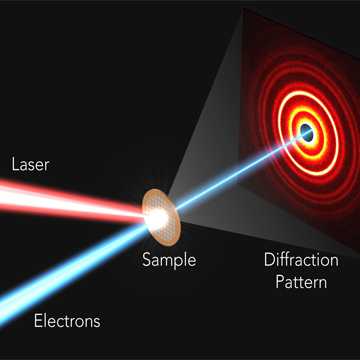
An electron beam is deflected as it passes through a perovskite sample, generating an intensity or diffraction pattern on a detector. [Image: Greg Stewart, SLAC National Accelerator Laboratory]
Photovoltaic cells made of perovskites are highly efficient, but scientists still don’t know exactly why. Now, researchers at a U.S. laboratory have probed perovskites’ crystalline structure with an ultrafast “electron camera” to reveal its unusual response to light, which may help explain the structure’s efficiency (Sci. Adv., doi:10.1126/sciadv.1602388).
Ultrafast electron diffraction
Scientists at SLAC National Accelerator Laboratory in California examined methylammonium lead iodide, one of the most intensively studied synthetic perovskites. Solar cells made with the material exhibit efficiencies upwards of 20 percent, which could be improved with a greater understanding of the interactions between charge carriers and the underlying lattice.
The SLAC scientists created a thin film of perovskite, the crystal structure of which looks like an array of octohedra. The team then blasted the film with both a 400-nm light from a Ti-sapphire femtosecond pump laser and 300-fs pulses from a 3.7-MeV electron beam probe. This technique, called ultrafast electron diffraction, resulted in a series of diffraction images recorded on an electron-multiplying charge-coupled device.
Excitation with the pump beam decreased the intensities of all the Bragg peaks in the diffraction images and increased the scattering in the regions between the Bragg peaks. By taking repeated snapshots, the scientists could see how the crystal structure was reacting to the light, and modeling techniques provided the insight into the results.
A surprising finding
To their surprise, the SLAC researchers found that the lattice molecules were being deformed out of their octahedral shape in an unusual way. Iodine atoms surrounding the central lead atoms rotated around them while maintaining the same distance from the lead. In other words, photoexcitation caused the bond angles between the lead and iodine atoms to change. The rotational distortion of the lattice structure started within 10 picoseconds of the light pulse hitting the perovskite film.
The SLAC team’s results show that the inorganic parts of the perovskite lattice also have important interactions with charge carriers. That differed from some previous studies of methylammonium lead iodide that had focused on the organic dipoles attached to the lattice.
